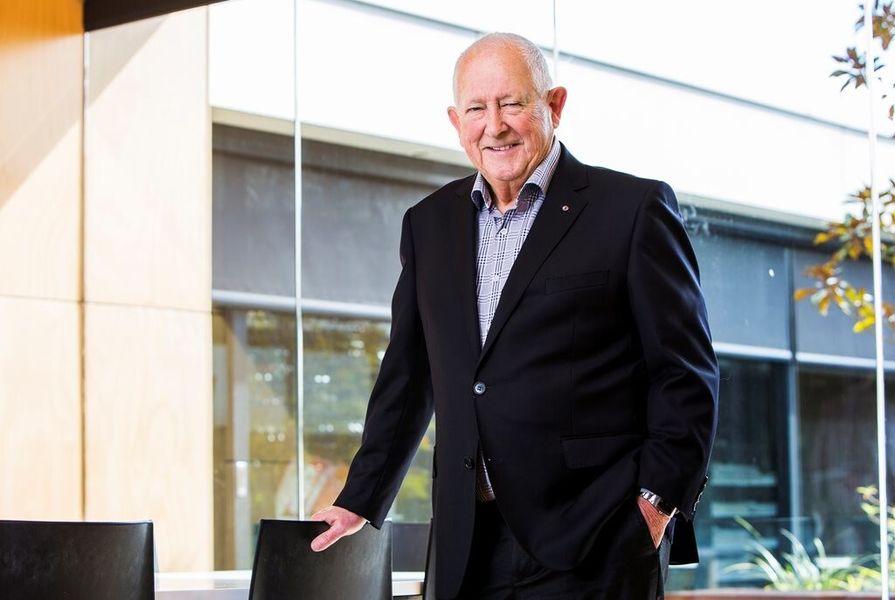Australian architecture has lost one of its quietly brilliant changemakers. The designer of the first new government school by a private architect and founder of the first major independent secular school in Australia, Les Clarke AM was a born pioneer. To the many who knew and loved him, he was also a skilled masterplanner, a playful fun-lover, a thoughtful friend, an unconventional problem-solver, and an encouraging mentor – particularly of young graduates and women in a male-dominated industry. He was also a strategic businessperson, unafraid to take risks, a visionary always with one eye on the next opportunity, and a talent-spotter extraordinaire. He gave hundreds of Australian designers their break and helped his practice weather several recessions through innovative thinking and openness to change. He knew a good idea when he had it or heard it, and he backed people 100 percent to pursue theirs. If Les had a motto, it was, “Go for it.”
Les Clarke co-founded ClarkeHopkinsClarke Architects in 1960 with his friends and fellow RMIT architecture graduates David Hopkins and VFL captain-coach Jack Clarke. In 1973, when Les founded and designed Eltham College, chalk, talk and tests still ruled in schools. Standardized facilities were built quickly and easily using design templates to meet the needs of rapidly growing suburbs. In Victoria, the Public Works Department allocated designs and budgets based on projected enrolments. Catholic schools were sharing facilities like school halls with their parishioners, but not the broader community. Wealthy independent schools were appointing architects to design facilities like performing arts centres and sports stadiums, but they were for school use. There were no financial incentives or perceived benefits in co-creating facilities for broader community use. Schools were narrowly defined places, and largely vacant outside school hours.
Les changed all that. A young father living in Eltham in Melbourne’s north-eastern suburbs, he went looking for a progressive local school for his daughter Helen and found none. Encouraged by his client and friend Bert Stevens, then Principal of Essendon Grammar School, he rallied fellow parents around an inspiring vision: Eltham College, the first major independent secular school in Australia, funded by a co-operative of parents and designed by an architect as a shared resource for its local community.
The Eltham College Community Association (ECCA) Centre, completed in 1976.
Image: Supplied
The school pioneered bespoke, collaborative educational design, responding to the school’s particular site, educational vision and community needs. Its multi-award winning Eltham College Community Association (ECCA) Centre, built in just six months, comprised a games hall, gymnasium, swim centre, squash court, licensed restaurant, and one of the first commercial childcare centres in Victoria. The combination was unlike anything produced by design templates.
This inspired then State Education Minister Lindsay Thompson to challenge Les (and, unbeknownst to him, another designer) to deliver a second exemplar of contemporary educational design within six months. Gladstone Views Primary School became the first new government school designed by a private architect rather than the Public Works Department. Les’s design cemented change with its then-radical open-plan learning environment, which was delivered below the standard cost using a classic factory structure of steel frame, concrete floor, and sawtooth roof.
This project showed politicians the benefits of affordable, bespoke design in meeting community needs. As a result, the minister changed policy and resource allocation to allow schools to work directly with architects on bespoke designs that would respond to their vision and community needs. His successor co-opted the ECCA Centre concept and declared every school in the state should have one. This opened enormous design opportunities for Australian schools and architects.
Eltham College became Les’s best-known project, but when we interviewed him recently for an upcoming book about the evolution of schools as community hubs in Australia, he rated his design for Gladstone Views as “at least as influential” behind the scenes. ClarkeHopkinsClarke went on to create co-op-funded ECCA Centres at eight more schools across Melbourne, and Les evolved the concept further. With support from the Whitlam government, he undertook a six-month study tour of independent and government schools nationally with a retired principal and quantity surveyor. Together, they developed the space schedule we know today. This average cost structure for schools informed architects as they began to develop bespoke designs for schools state-wide.
Les’s commitment to research and good economic sense was central to his success as an advocate and changemaker. He went on to visit international exemplars of contemporary educational design in the United States, United Kingdom, and Europe. Looking back, he said it was research that gave him the vision, passion and confidence that inspired buy-in from parents and politicians. “Research makes a champion,” he said. “When you do the research, you can push yourself to the forefront because you’re coming up with ideas based on good evidence.”
In 1992, Les was made a Member of the Order of Australia “in recognition of service to the community through the design of schools that incorporate community facilities”. But over a 56-year career, his innovative thinking influenced many other areas of architecture, too. ClarkeHopkinsClarke partner Dean Landy, urban design and mixed-use lead, said Les was an early champion of what we now know as the 15 Minute City. “In his later years, Les was very focused on the masterplanning and creation of new towns and activity centres across Victorian growth areas that were people-focused and aimed to help build more vibrant communities that integrated all the needs of daily life,” Dean said. “What many in the industry now refer to as the 15 Minute City, Les had been working to integrate for decades.”
Co-founder of Clarke Hopkins Clarke, Les Clarke, at the drawing board.
Image: Supplied
Recently retired ClarkeHopkinsClarke Partner Robert Goodliffe said Les’s broad knowledge and intrinsic feel for masterplanning made him the go-to for initial concepts on everything from residential and commercial developments to retirement villages, aged care facilities and retail centres. “Les always knew where to start and how to site things,” he recalled. “He’d draw up the initial concepts freehand and they always had great balance between requirements, plenty of flexibility, and made real commercial sense.”
Les retired officially in 2016 but remained characteristically active in life and design until well into his 80s. He was still advocating for innovative, community-focused projects as recently as December 2022. He was a loving husband, father, and grandfather; a revered Founding Chairman and Life Member of Eltham College; a former Eltham Councilor and Shire President. And he was an exceptional human being whose legacy on us, both personally and professionally, was profound. The strong relationships he established are the reason our practice is still collaborating with Eltham College and many others on new spaces to meet changing needs. His legacy is still helping to drive the evolving community hubs movement, which consistently produces many of the Australia’s most innovative learning environments and community partnerships.
Since his passing, people of all ages have shared remarkably similar stories about Les, who recognized something in them and took the risk to give them a go. Les listened intently and backed ideas he believed in, no matter who they came from. Senior architectural technician Karin Matthews said that like many great leaders, Les gave everyone from young graduates to senior designers his undivided attention and was genuinely interested in their ideas and lives. “Whenever I needed to talk to him or ask a question, he would put his pen down, stop and listen, and talk to me,” she said. “I think that’s a measure of the man. He cared. If you put in, he would give you absolutely everything.”
“I was always inspired by the way Les saw a need for a good school and just set one up,” said Dean. “You don’t meet many people like that. That’s had a direct influence on what I’m doing with One Heart Foundation in Africa, helping communities set up schools and sustainable livelihoods. Les was always looking to pioneer. He showed me that we should never talk ourselves out of doing something because it seems too hard.”
Health Partner Cath Muhlebach recalled “the glint in his eye when he was discussing ideas and opportunities”. As an optimist and creative, he worked hard and remained open to new approaches throughout his life. “With Les you got the sense that there was always a solution and a way to work together to solve a problem, whether in a plan, on site or in life,” she said. “He knew the first solution wasn’t the only one. Things had to be tested and worked through. I found that very inspiring. He was always very ready to scrunch up a drawing and start again.”
A memorial for Les Clarke will be held on Tuesday 7 February at Eltham College Sports Centre at 2.30pm.
– Simon LeNepveu and Justin Littlefield are Partners at ClarkeHopkinsClarke Architects. Simon interviewed Les recently for an upcoming book about 50 years of designing schools as community hubs. Justin attended Eltham College, was hired by Les Clarke as a graduate architect, and through Les’s encouragement spearheaded the practice’s move into healthcare design.




















